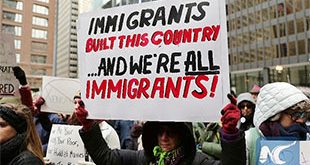
The 1951 Convention does not specify how you share the burden and responsibility, and that’s what the global compact does. “It responds to one of the major gaps we have faced for decades”.
But why do we need a new international agreement?
At the end of 2017, there were nearly 25.4 million refugees around the world, more than half of whom are under the age of 18. Today, just 10 countries host 60 per cent of the world’s refugees. Turkey alone hosts 3.5 million refugees, more than any other country. Furthermore, the vast majority of the world’s refugees (85 per cent) live in developing countries that face their own economic and development challenges.
Ten governmental donors (including the European Union) provide almost eighty per cent of UNHCR’s funding, for example, and more than two-thirds of UNHCR’s resettlement submissions go to just five countries. The gap between the needs of refugees and action to meet them is large and growing.
Who decided to create this compact? The UN, UNHCR?
No, it was decided by Member States. The New York Declaration for Refugees and Migrants, adopted by Member States in September 2016 included two key steps in relation to refugees:
· First, Member States adopted the comprehensive refugee response framework’, which sets out a wide range of measures to be taken by the international community when responding to a large-scale refugee situation.
· Secondly, Member States agreed to continue to improve international responses by working towards the adoption of a ‘global compact on refugees’ in 2018. They asked the United Nations High Commissioner for Refugees (UNHCR) to consult with Member States and a wide range of other stakeholders and propose such a compact. The proposed global compact on refugees was released on 20 July 2018.
How was the global compact on refugees negotiated?
It has been developed through an extensive multilateral process of consultation with Member States and other key stakeholders.
On 13 November 2018, the Social, Humanitarian and Cultural (Third) Committee of the UN General Assembly approved the resolution which affirms the refugee compact with overwhelming majority and has sent the text to the General Assembly plenary for adoption, scheduled for the morning of 17 December 2018.
How will the global compact on refugees work?
The global compact on refugees establishes the architecture for a stronger, more predictable and more equitable international response to large refugee situations.
Although not legally binding, it guides the international community in supporting refugees and countries and communities hosting large numbers through the mobilization of political will, a broadening of the base of support, and the activation of arrangements for more equitable and predictable burden- and responsibility-sharing.
“Refugees are an international concern, and a shared responsibility,” the UN High Commissioner for Refugees Filippo Grandi said. “In the compact, we will for the first time have a practical workable model, a set of tools that translates this principle into action.”
“Decades of keeping refugees apart, consigned to camps or on the margins of society are giving way to a fundamentally different approach – including refugees in national systems, societies and economies of their host countries for the time that it is necessary, and enabling them to contribute to their new communities and to secure their own futures, pending a solution to their plight,” Grandi explained, noting the that the global compact started with the generosity of these communities.
 The Independent Uganda: You get the Truth we Pay the Price
The Independent Uganda: You get the Truth we Pay the Price



